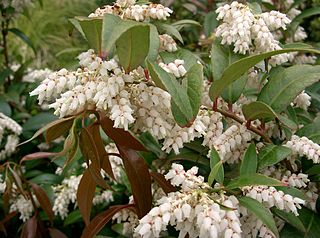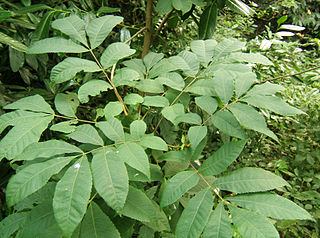
The pecan is a species of hickory native to the southern United States and northern Mexico in the region of the Mississippi River. The tree is cultivated for its seed in the southern United States, primarily in Georgia, New Mexico,and Texas, as well as Mexico, which produces nearly half of the world total. The seed is an edible nut used as a snack and in various recipes, such as praline candy and pecan pie. The pecan, in various aspects, is included in state symbols of Alabama, Arkansas, California, Oklahoma, and Texas.

Hickory is a common name for trees composing the genus Carya, which includes around 18 species. Five or six species are native to China, Indochina, and India (Assam), as many as twelve are native to the United States, four are found in Mexico, and two to four are native to Canada. A number of hickory species are used for products like edible nuts or wood.

Leucothoe is a genus of about 6 species of flowering plants in the family Ericaceae, native to Asia and the Americas. Many species have the common name doghobble. Leucothoe species contain grayanotoxins, a group of closely related neurotoxins named after Leucothoe grayana, native to Japan.

Carya ovata, the shagbark hickory, is a common hickory in the Eastern United States and southeast Canada. It is a large, deciduous tree, growing well over 100 ft (30 m) tall, and can live more than 350 years. The tallest measured shagbark, located in Savage Gulf, Tennessee, is over 150 ft (46 m) tall. Mature shagbarks are easy to recognize because, as their name implies, they have shaggy bark. This characteristic is, however, only found on mature trees; young specimens have smooth bark.

Breynia is a plant genus in the family Phyllanthaceae, first described in 1776. It is native to Southeast Asia, China, the Indian Subcontinent, Papuasia, Australia, and the island of Réunion.
Annamocarya is a genus of flowering plants in the family Juglandaceae, containing only one species, Annamocarya sinensis, native to southwestern China and northern Vietnam. It is related to the hickories, and was formerly included in the same genus Carya, as Carya sinensis, but also shares a number of characteristics with the walnuts in the genus Juglans. It is grouped with Carya in the subtribe Caryinae. It is sometimes called Chinese hickory or beaked hickory.

Nichols Arboretum, locally known as the Arb, is an arboretum operated by the University of Michigan. Located on the eastern edge of its Central Campus at 1610 Washington Heights in Ann Arbor, Michigan, the Arboretum is a mosaic of University and City properties operated as one unit. The arboretum is open daily from sunrise to sunset with no charge for admission. The Huron River separates a northern section of the arboretum's floodplain woods; the railroad marks the northern border.

Carya cordiformis, the bitternut hickory, also called bitternut or swamp hickory, is a large pecan hickory with commercial stands located mostly north of the other pecan hickories. Bitternut hickory is cut and sold in mixture with the true hickories. It is the shortest-lived of the hickories, living to about 200 years.

Carya laciniosa, the shellbark hickory, in the Juglandaceae or walnut family is also called kingnut, big, bottom, thick, or western shellbark, attesting to some of its characteristics. It is a slow-growing, long-lived tree, hard to transplant because of its long taproot, and subject to insect damage. The nuts, largest of all hickory nuts, are sweet and edible. Wildlife and people harvest most of them; those remaining produce seedling trees readily. The wood is hard, heavy, strong, and very flexible, making it a favored wood for tool handles. A specimen tree has been reported in Missouri with 117 cm (46 in) diameter at breast height, 36.9 m tall, and a spread of 22.6 m.

Dalbergia cochinchinensis, the Thailand rosewood, Siamese rosewood, or tracwood, is a species of legume in the family Fabaceae.

Dalbergia tonkinensis is a species of legume in the family Fabaceae. It is a small tree, 5–13 metres (16–43 ft) tall, found in Hainan Island of China and Vietnam. It is threatened by habitat loss and overexploitation for timber.
Sindora tonkinensis is a species of legume in the family Fabaceae. This up to 15 m (49 ft) tall tree is native to Cambodia and Vietnam, and it is cultivated in Guangdong in southern China.

Gastrodia, commonly known as potato orchids or as 天麻属 , is a genus of terrestrial leafless orchids in the family Orchidaceae, about ninety of which have been described. Orchids in this genus have fleshy, upright stems and small to medium-sized resupinate flowers with narrow sepals and petals. They are native to Asia, Australia, New Zealand, central Africa, and various islands of the Indian and Pacific Oceans.
Mouretia tonkinensis is a species of plant in the family Rubiaceae. It is endemic to Vietnam.
Acheilognathus tonkinensis is a species of cyprinid fish in the subfamily Acheilognathinae. It is found in northern Vietnam, Laos, and southern China. It occurs in rivers and deposits its eggs inside freshwater mussels.

Curculigo is a flowering plant genus in the family Hypoxidaceae, first described in 1788. It is widespread across tropical regions of Asia, Africa, Australia, and the Americas.
Deutzianthus tonkinensis is a species of small tree up to 12 metres (39 ft) tall in the family Euphorbiaceae. It is found in southern China and northern Vietnam. The species is under second-class national protection in China.

Carya pallida, sand hickory, or pale hickory is a species of hickory native to the southeastern United States. It is a perennial, dicotyledonous plant which prefers rocky or sandy habitats. The sand hickory can reach heights of up to 30m, but its typical height is between 9-24m. In an open area, Carya crowns are usually towering and slim. The sand hickory nut is edible and consumed by various organisms.
Carya poilanei is a very large species of hickory native to northern Laos, northern Vietnam, Thailand, and southern China. It was first described by Auguste Jean Baptiste Chevalier, and given its current name by André Leroy. Carya poilanei is part of the genus Carya, and the family Juglandaceae.
Petelotiella is a monotypic genus of flowering plants belonging to the family Urticaceae. It only contains just one species, Petelotiella tonkinensis(Gagnep.) Gagnep.













